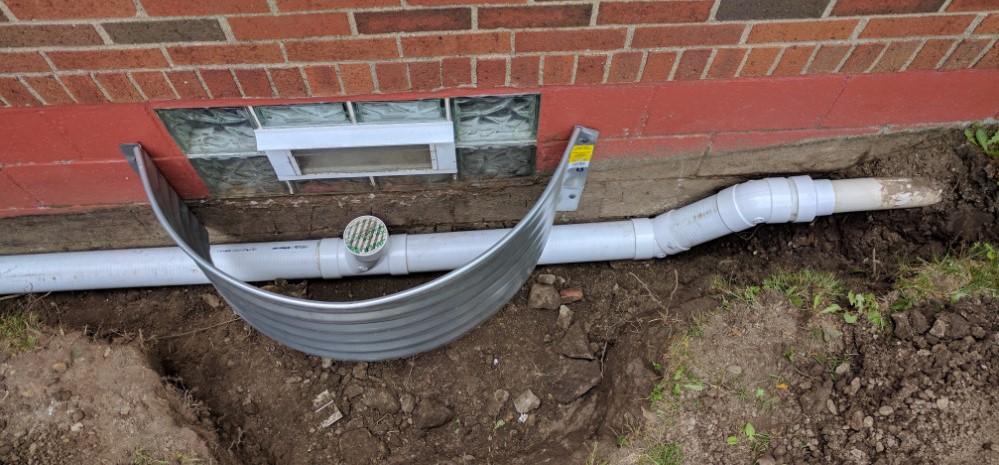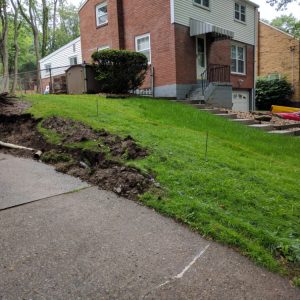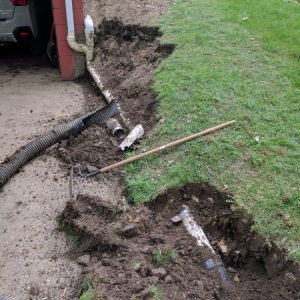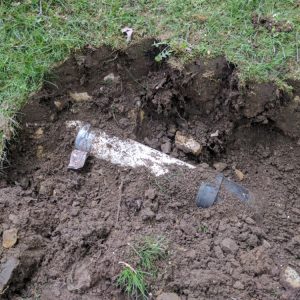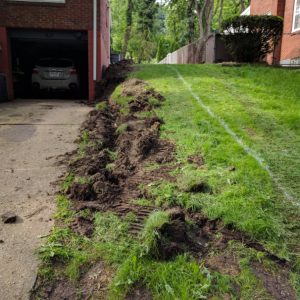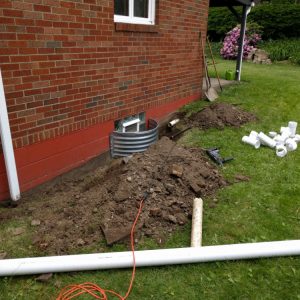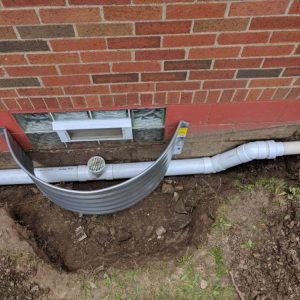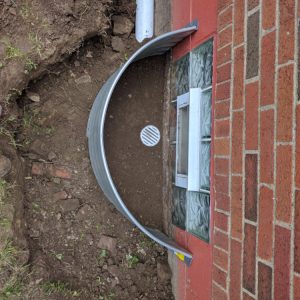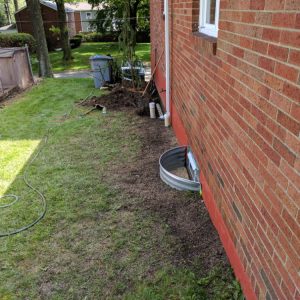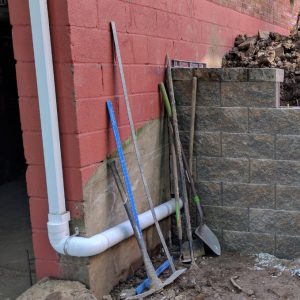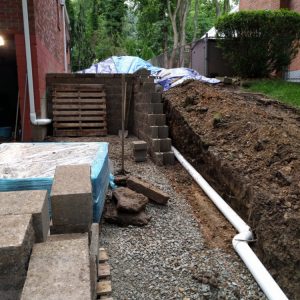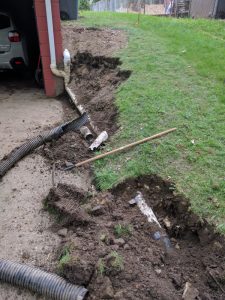 Last fall I spent several days digging out the old terracotta gutter drains, brick window basin, and re-grading the west side of the house to resolve drainage issues I was having during heavy rain. When the weather broke this spring, it was time to tackle the other side of the house. Originally I was unsure how I was going to re-grade the east side as it was extremely sloped, and decided instead to install a French drain.
Last fall I spent several days digging out the old terracotta gutter drains, brick window basin, and re-grading the west side of the house to resolve drainage issues I was having during heavy rain. When the weather broke this spring, it was time to tackle the other side of the house. Originally I was unsure how I was going to re-grade the east side as it was extremely sloped, and decided instead to install a French drain.
After having a friend move in and realizing that the parking situation was sub-par when visitors came over, I stepped back and redesigned this whole part of the project. After consulting with the city building inspector, it was determined that the amount of dirt I would be moving was under the limit set in the code books; I was also far enough away from the property line that the retention wall was not going to cause trouble and it was under the height that would trigger a state inspection. From this, the driveway expansion project (coming soon to a website near you) was born.
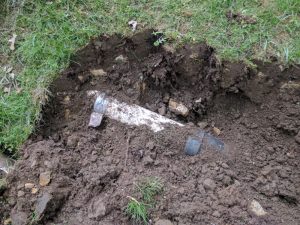 Originally, there was a 3-inch DWV line running through the side yard picking up the back, side, and front gutters. This pipe was too small for heavy rains and would back up. Aside from this slight issue, it was also buried too shallow and had surfaced and started to push onto the driveway. Down near the driveway the DWV pipe transitioned to corrugated ABS that was only buried a few inches under the grass, poking through the surface in several areas. I noticed two other white PVC pipes buried in the yard, that would only dribble water during extremely heavy rain; I had no idea what they were for.
Originally, there was a 3-inch DWV line running through the side yard picking up the back, side, and front gutters. This pipe was too small for heavy rains and would back up. Aside from this slight issue, it was also buried too shallow and had surfaced and started to push onto the driveway. Down near the driveway the DWV pipe transitioned to corrugated ABS that was only buried a few inches under the grass, poking through the surface in several areas. I noticed two other white PVC pipes buried in the yard, that would only dribble water during extremely heavy rain; I had no idea what they were for.
As you can see in the photo above, this collection of pipes should have been connected at one point, but was bypassed. I later came to find that this pipe was crushed and filled with dirt somewhere along the line, diverted, clogged again, and re-diverted one more time with the corrugated pipe that was now exposed. Along with the odd number of transitions from thin-wall DWV to SCH40 pipe, to ABS, corrugated, even some terra-cotta, most of the pipe was “joined” using little more than a single wrap of Duck Tape.
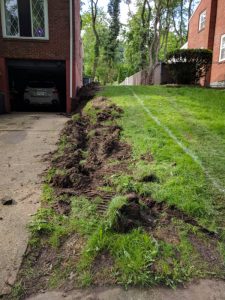
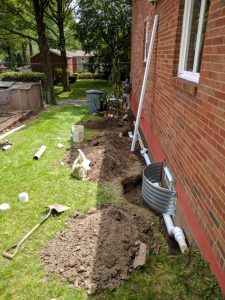 Right around this time I called my old boss and asked if it would be possible to borrow a front loader over the Memorial Day weekend to complete the much larger driveway job. I couldn’t have done this without his assistance. I queried PA OneCall (811) and verified the location of the utilities (several pipes were still marked incorrectly, but that wasn’t an issue) and began digging. It took several hours but I was able to remove all of the old drainage lines.
Right around this time I called my old boss and asked if it would be possible to borrow a front loader over the Memorial Day weekend to complete the much larger driveway job. I couldn’t have done this without his assistance. I queried PA OneCall (811) and verified the location of the utilities (several pipes were still marked incorrectly, but that wasn’t an issue) and began digging. It took several hours but I was able to remove all of the old drainage lines.
Along the side of the house my friend Gary and I teamed up and dug out the old storm drain. I bumped up the pipe size to four inches, dug down another 20 inches below the old pipe, and also added a drain below the faucet for a future pad. While I was working on this, I also added a window well to this side of the house. You may notice that this thin-wall pipe is not perforated. Instead of putting in a French drain, I opted to use the soil from the driveway to re-grade this entire side of the house –raising it nearly three feet so the water would properly drain. The window well also got a new drain to ensure water wouldn’t collect and form a pool.
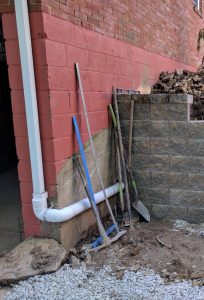 After the completion of the upper section of pipe, it was back-filled with gravel then topped off with the dirt that was removed. Construction of the driveway extension began and work on the drain halted for about a week. The driveway digging only took a day and a half, but it was necessary to get the initial string of block run for the wall before placing perforated pipe behind it to pick up excess water.
After the completion of the upper section of pipe, it was back-filled with gravel then topped off with the dirt that was removed. Construction of the driveway extension began and work on the drain halted for about a week. The driveway digging only took a day and a half, but it was necessary to get the initial string of block run for the wall before placing perforated pipe behind it to pick up excess water.
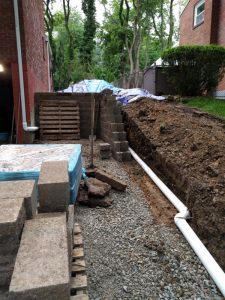 The front gutter was mounted, drain tied into the line we previously ran using a wye, then the line transitioned to perforated behind the wall using a 90° thin wall sweep. This storm drain is solid the rest of the way out to the road, and it no longer dumps water on the driveway. This setup has worked amazingly well and pulls far more water from the property than I had ever seen prior. Another fantastic improvement is the fact that water will no longer dump on the driveway over the winter, causing extreme ice sheet formation.
The front gutter was mounted, drain tied into the line we previously ran using a wye, then the line transitioned to perforated behind the wall using a 90° thin wall sweep. This storm drain is solid the rest of the way out to the road, and it no longer dumps water on the driveway. This setup has worked amazingly well and pulls far more water from the property than I had ever seen prior. Another fantastic improvement is the fact that water will no longer dump on the driveway over the winter, causing extreme ice sheet formation.
All in all, the drainage itself was a fairly simple and cheap project. It is unbelievable how much rock is buried in this area of PA so this process is extremely tough work. Keep an eye out for the driveway extension project as this would not have been possible without it.
Enjoy the weather, and always keep improving!
